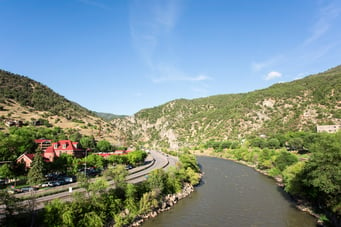
Summer is quickly approaching which means we will soon be enjoying time in or along the rivers that flow through Eagle County. The Eagle River flows into the Colorado River in Dotsero. The Colorado River is not only an important resource for us in Eagle County but it also serves as a crucial resource for 7 states, 2 countries, 9 national parks and approximately 36 million people (a number that is increasing annually). With this being such an important resource, the question becomes, where does the Colorado River get its water?
The headwaters of the Colorado River are located near Lake Granby, but most of the water comes from snowmelt from the Rocky Mountains in Colorado and Wyoming. Infact, between 80 and 90 percent of the water is from this snowmelt. The rest comes from groundwater or monsoon season storms in the summer. With so much of the water coming from snowmelt, what exactly does our snowpack look like for this year?
If you have been enjoying the outdoors at all this winter you likely have noticed that the snowpack seems lighter than usual. Although one may think using snowpack depth is the way to calculate how much water will come from the winter’s snow. The snowpack depth can vary hourly based on how it settles and compresses, therefore it is not an accurate measure of water content. The more accurate way to determine how much water we will get from the snow in a season is by looking at the snow water equivalent (SWE). SWE is the amount of water that is in the snow and that will become available once the snow melts. Unlike snowpack depth, the water content in the snow does not vary over time. SWE is used by hydrologists to determine how much water we will have when the snow melts.
On average the SWE in early April is about 16 inches. This year, our SWE for early April is only 13 inches. This is several inches less compared to this time last year where we had almost 17 inches. As of April 15th, the Colorado Headwater River Basin is at about 70% of its normal snow water equivalent. We are already seeing lower than average flow in the Colorado River for this year. At a US Geological Survey stream gage located in the Colorado River at the Colorado-Utah state border, the flow for this year is about 62% of the average flow.
Climate change combined with the rapidly increasing population within the Colorado River Basin is not doing the river any favors. While it is extremely difficult to calculate exactly how much the flow of the river will decrease, the average flow of the river is expected to decrease between 14 and 31 percent by 2050. The outlook is bleak but, there are many organizations working to protect the Colorado River. Colorado’s Department of Natural Resources has a plan that is working to protect the Colorado River while also making sure that there is water available to the people and places that rely on the river.
While one of the best ways to protect and preserve the Colorado River is through policy, we can all play a part in protecting the Colorado River. As residents within the Colorado River Basin, we can protect and preserve our water by trying to reduce our water footprint. You can use an online water footprint calculator (www.watercalculator.org) to determine how much water you use and to find more ways that you can reduce your water usage. That water spewing out of your faucet is basically liquid gold, so remember, as the snow melts and rivers rise, this valuable resource must be protected so that we can continue to enjoy all the benefits our local waterways provide.
Kelly Luebbering is a winter naturalist at Walking Mountains Science Center who enjoys running along the Colorado River.
https://www.npca.org/advocacy/16-protect-the-colorado-river
https://pubs.usgs.gov/fs/2004/3062/
https://cowaterplan.colorado.gov/the-basins/colorado-river
http://snowpack.water-data.com/uppercolorado/index.php?getall=1









